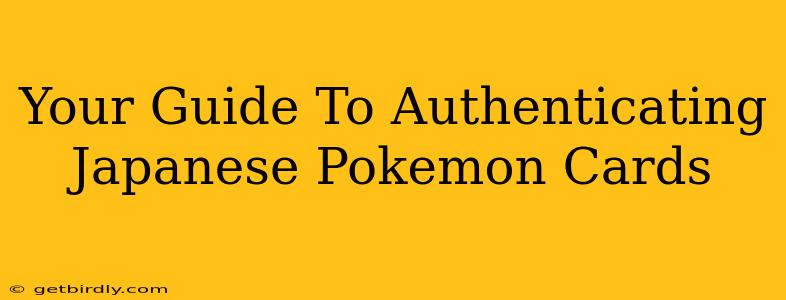Your Guide to Authenticating Japanese Pokémon Cards
The world of Pokémon card collecting is vast and exciting, with Japanese cards often holding a special allure for their unique artwork and sometimes higher value. However, the popularity of these cards has unfortunately led to a rise in counterfeits. This comprehensive guide will equip you with the knowledge and tools to authenticate Japanese Pokémon cards, helping you avoid costly mistakes and build a genuine collection.
Why Authenticate Japanese Pokémon Cards?
Before diving into authentication methods, let's understand why it's crucial. Counterfeit cards can significantly devalue your collection and potentially lead to financial losses if you intend to sell. Authentic Japanese Pokémon cards often command higher prices due to their rarity, condition, and historical significance, making them prime targets for counterfeiters. Investing time in learning authentication techniques is a smart investment in protecting your collection and your money.
Key Features to Examine: A Visual Inspection Checklist
The first step in authentication is a thorough visual inspection. Look closely at these key features:
1. Card Stock and Texture:
- Authenticity: Genuine Japanese Pokémon cards typically have a slightly thicker, more rigid card stock than their English counterparts. They also possess a distinct texture; it’s slightly smoother than many modern English cards. Feel the card – a counterfeit often feels flimsy or excessively glossy.
- Counterfeit Indicators: Thin, flimsy card stock, a noticeably different texture (too glossy or rough), or inconsistencies in the thickness across the card are all red flags.
2. Print Quality and Color Accuracy:
- Authenticity: Look for crisp, sharp lines and vibrant, consistent colors. The printing should be even and free of blurry spots or smudging. Japanese cards are generally known for their high-quality printing.
- Counterfeit Indicators: Fuzzy or blurred images, faded colors, misaligned printing, or color inconsistencies are strong indicators of a counterfeit.
3. Artwork and Text:
- Authenticity: Compare the card's artwork and text to reputable online databases like PokéBeach or Bulbapedia. Pay close attention to details—subtle differences in shading, linework, or font can reveal a forgery. The text should be accurately translated and consistent with the original artwork.
- Counterfeit Indicators: Significant deviations from established artwork, misspellings, unusual font styles, or inconsistencies in text size and placement raise serious doubts about authenticity.
4. Set Symbol and Holofoil:
- Authenticity: The set symbol (the small symbol indicating the set the card belongs to) should be clear, sharp, and correctly positioned. Holofoil (if applicable) should be evenly distributed and shimmer naturally. Examine the placement and pattern meticulously.
- Counterfeit Indicators: A blurry or misaligned set symbol, uneven or poorly applied holofoil, or a holofoil pattern that's too bright or dull compared to legitimate examples are critical warning signs.
Addressing Specific Counterfeit Tactics
Counterfeiters constantly adapt their techniques. Be aware of common methods they use:
3. The "Reverse Holo" Test: A common method for counterfeiters is to print a reversed holofoil effect. Rotate the card, and observe the way the holo effect changes—it should be consistent and not appear "flat" or "muddy."
4. Watermark Inspection: Some genuine cards incorporate subtle watermarks. Hold the card up to a light source and look for these markings (although this is not consistent across all sets and rarities).
Utilizing Online Resources and Communities
Don't rely solely on visual inspection. Leverage online resources:
- PokéBeach: A well-respected resource for Pokémon card information, including images and set lists.
- Bulbapedia: A comprehensive Pokémon encyclopedia with detailed information on cards.
- Online Forums and Communities: Engage with experienced collectors in online forums and communities dedicated to Pokémon cards. They can offer valuable insights and assistance in authentication.
When in Doubt, Seek Professional Assistance
If you remain unsure about a card's authenticity after conducting thorough checks, consider seeking professional appraisal from a reputable card grading service or a trusted Pokémon card expert. While this might incur a cost, it's a worthwhile investment to protect your collection and avoid potentially significant losses.
Conclusion: Building a Genuine Collection Takes Time and Diligence
Authenticating Japanese Pokémon cards demands patience and attention to detail. By mastering these techniques and utilizing available resources, you can significantly reduce the risk of acquiring counterfeit cards and build a collection of genuine, valuable assets. Remember, taking your time and being thorough is key to ensuring the authenticity of your prized Pokémon possessions.

